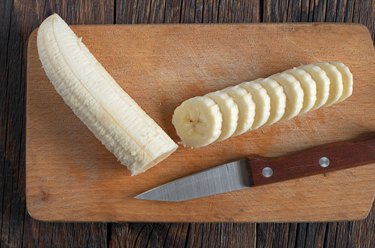
Few things are more delicious than an overripe banana bursting with flavor. It's naturally sweet and makes a healthy snack when sugar cravings hit. These fruits can go bad, though, so make sure you know how to tell the difference between a bad banana and one that's overripe.
Tip
Bananas that have a musty smell, fruit flies, mold on the stems or signs of rot and decay are no longer safe to eat. An overripe banana that looks and smells fine, on the other hand, doesn't pose any health risks.
Video of the Day
Why Do Bananas Turn Brown?
Rich in potassium, fiber and polyphenols, bananas pack a hefty nutritional punch. With only 112 calories per serving (4.4 ounces), it can replace your go-to snacks and make it easier to cut down on sugar. The catechins, carotenoids and other antioxidants in this fruit may protect against heart and liver disease, reduce free radical damage and boost your mood, according to a December 2018 review published in Food Quality and Safety.
Video of the Day
Unfortunately, these delicious fruits can go bad quickly. Their color often changes from one day to the next. A green banana can turn brown in less than a week or so.
As it turns out, ethylene gas is the culprit. This plant hormone regulates the ripening process, changing fruit color, flavor, texture and nutritional content. Once it reaches certain levels, it causes the fruit cells to expel carbon dioxide instead of oxygen, reports Fine Cooking magazine. Additionally, certain fruits, such as bananas, pears and apricots, tend to retain more ethylene as they reach maturity.
Is an Overripe Banana Safe?
A ripe banana has yellow skin with lots of brown spots. Its flesh may have small brown spots, too. This sign of ripeness, though, doesn't mean that you're dealing with a bad banana. You can simply cut off the brown parts and enjoy the fruit as is or add it to smoothies, protein shakes and homemade desserts.
In fact, ripe bananas may be even healthier than their green counterparts. According to a December 2014 review featured in Pediatric Gastroenterology, Hepatology & Nutrition, unripe bananas are high in tannins and resistant starch, which may cause or worsen constipation. Resistant starch is a type of carbohydrate that remains intact in the digestive tract and ferments in the bowel. The amount of starch and tannins decreases when green bananas are cooked or become ripe.
Furthermore, antioxidant levels in these fruits increase as they reach maturity. A study published in the International Food Research Journal in December 2013 found that ripe bananas were higher in sugar, vitamin C and phenolic compounds. However, their nutritional value decreased when they became overripe.
You may eat an overripe banana as long as it's free of mold or strange odors. Since these fruits don't have a "best before" date attached to them, it can be hard to tell when they go bad.
There are a few telltale signs to watch out for, though. Always check for fruit flies, mold on the banana stem, mildew-like scents, rot and decay, especially when you're dealing with fully ripe bananas.
Keep Bananas Fresh for Longer
A bad banana with mold and signs of decay is anything but healthy. The good news is, you can keep these fruits fresh for longer with a few simple tricks.
Fine Cooking recommends putting bananas in plastic bags and storing them in the fridge. Some people keep them in the freezer. That's not a good idea. Temperatures below 50 degrees Fahrenheit may cause chill injuries to these fruits, affecting their flavor, color and texture.
Keep the peel on after cutting a banana, advises Cooking Light. This prevents oxygen from having contact with the fruit. Ideally, slice them right before use.
The experts at Cooking Light also recommend coating sliced bananas with lemon or lime juice, vinegar, or honey thinned with water to prevent oxidation and enhance their flavor. In general, acidic substances, such as orange juice, slow the oxidation process.
If your bananas are already fully ripe, don't toss them. Instead, use them in homemade ice cream, fruit purees, banana bread, smoothies, granola bars, pancakes and desserts. For example, you can blend an overripe banana with oatmeal and peanut butter, bake the dough and cut it into cookies for an energy-boosting snack.
- USDA: "Nutrition Facts for Bananas"
- Food Quality and Safety: "Bioactive Compounds in Banana Fruits and Their Health Benefits"
- NCBI: "Banana Ethylene Response Factors Are Involved in Fruit Ripening Through Their Interactions With Ethylene Biosynthesis Genes"
- Fine Cooking: "The Science of Ripening"
- Pediatric Gastroenterology, Hepatology & Nutrition: "Diets for Constipation"
- Johns Hopkins University: "What Is Resistant Starch?"
- Cooking Light: "How to Store Cut Bananas So They Last Longer and Taste Their Best"